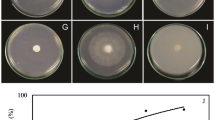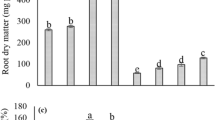Abstract
One of the most severe diseases affecting soybean is the Asian Soybean Rust (ASR) caused by Phakopsora pachyrhizi H. Sydow & P. Sydow. The oxidative damage in cellular constituents and the disruption in the photosynthetic apparatus are the major negative effects of ASR on soybean plants. Considering the importance of nickel (Ni) on plant metabolism, this study evaluated the effect of foliar Ni-supply on ASR control, reactive oxygen species (ROS) accumulation, activities of antioxidant enzymes, parameters related to photosynthesis, and sugars levels on soybean plants. ASR severity decreased by 34% due to Ni supply. Infected and Ni-supplied (+ Ni) plants showed lower malondialdehyde level and superoxide (O2−) and hydrogen peroxide (H2O2) accumulation in contrast to infected leaf tissues of non-Ni-supplied (− Ni) plants. The antioxidant enzymes activities were inefficient to avoid the high ROS accumulation for − Ni inoculated plants. The photosynthetic pigments, maximum photochemical efficiency of photosystem II (PSII), effective yield of PSII, electron transport rate, rate of net carbon assimilation, stomatal conductance to water vapor, and transpiration rate values were higher and the yield for other non-regulated losses and internal CO2 concentration values were lower for + Ni inoculated plants compared to − Ni inoculated plants. High ROS production and the greater damage to the photosynthetic apparatus caused by P. pachyrhizi infection on − Ni plants affected the synthesis of the sugars. The infection also decreased the plant’s energetic reserves faster in − Ni plants compared to + Ni plants. In conclusion, the cellular oxidative damage and the impairment on the photosynthetic apparatus of soybean plants caused by P. pachyrhizi infection were alleviated by supplying Ni foliarly.











Similar content being viewed by others
References
Ahmed AIS, Yadav DJ, Lee YS (2016) Applications of nickel nanoparticles for control of Fusarium wilt on lettuce and tomato. Int J Innov Res Sci Eng Technol 5:7378–7385
Akhtar P, Dorogi M, Pawlak K, Kovács L, Bóta A, Kiss T, Garab G, Lambrev PH (2015) Pigment interactions in light-harvesting complex II in different molecular environments. J Biol Chem 290:4877–4886
Antonkiewicz J, Jasiewicz C, Koncewicz-Baran M, Sendor R (2016) Nickel bioaccumulation by the chosen plant species. Acta Physiol Plant 38:40
Aucique-Pérez CE, Resende RS, Neto LBC, Dornelas F, DaMatta FM, Rodrigues FA (2019) Picolinic acid spray stimulates the antioxidative metabolism and minimizes impairments on photosynthesis on wheat leaves infected by Pyricularia oryzae. Physiol Plant. https://doi.org/10.1111/ppl.12917
Ayres PG (1981) Effects of disease on the physiology of the growing plant. Cambridge University Press, Cambridge, p 228
Bai C, Reilly CC, Wood BW (2006) Nickel deficiency disrupts metabolism of ureides, amino acids and organic acids of young pecan foliage. Plant Physiol 140:433–443
Barcelos JPQ, Reis HPG, Godoy CV, Gratão PL, Furlani Junior E, Putti FF, Campos M, Reis AR (2018) Impact of foliar nickel application on urease activity, antioxidant metabolism and control of powdery mildew (Microsphaera diffusa) in soybean plants. Plant Pathol 67:1502–1513
Barón M, Flexas J, Delucia E (2012) Photosynthesis responses to biotic stress. In: Flexas J, Loreto F, Medrano H (eds) Terrestrial photosynthesis in a changing environment: a molecular, physiological and ecological approach. Cambridge University Press, Cambridge, pp 331–350
Bonde MR, Melching JS, Bromfield KR (1976) Histology of the suscept-pathogen relationship between Glycine max and Phakopsora pachyrhizi, the cause of soybean rust. Phytopathology 66:1290–1294
Brown PH, Welch RM, Cary EE (1987) Nickel: a micronutrient essential for higher plants. Plant Physiol 85:801–803
Chen C, Huang D, Liu J (2009) Functions and toxicity of nickel in plants: recent advances and future prospects. Clean 37:304–313
Daloso DM, Antunes WC, Pinheiro DP, Waquim JP, Araújo WL, Loureiro ME, Fernie AR, Williams TC (2015) Tobacco guard cells fix CO2 by both Rubisco and PEPcase while sucrose acts as a substrate during light-induced stomatal opening. Plant Cell Environ 38:2353–2371
Debona D, Rodrigues FA, Rios JA, Nascimento KJT (2012) Biochemical changes in the leaves of wheat plants infected by Pyricularia oryzae. Phytopathology 102:1121–1129
Demidchik V (2015) Mechanisms of oxidative stress in plants: from classical chemistry to cell biology. Environ Exp Bot 109:212–228
Dixon NE, Gazzola C, Blakel RL, Zerner YB (1975) Jack-Bean urease (E.C.3.5. 1.5.3.) a metallo-enzyme, a simple biological role for nickel. J Am Chem Soc 97:4131–4133
Einhardt AM, Ferreira S, Hawerroth C, Valadares SV, Rodrigues FA (2020) Nickel potentiates soybean resistance against infection by Phakopsora pachyrhizi. Plant Pathol 69:849–859
Elmer WH, Datnoff LE (2014) Mineral nutrition and suppression of plant disease. In: Van Alfen N (ed) Encyclopedia of agriculture and food systems. Elsevier, San Diego, pp 231–244
Fagundes-Nacarath IRF, Debona D, Rodrigues FA (2018) Oxalic acid-mediated biochemical and physiological changes in the common bean-Sclerotinia sclerotiorum interaction. Plant Physiol Biochem 129:109–121
Fernie AR, Roscher A, Ratcliffe RG, Kruger NJ (2001) Fructose 2,6-bisphosphate activates pyrophosphate: fructose-6-phosphate 1-phosphotransferase and increases triose phosphate to hexose phosphate cycling in heterotrophic cells. Planta 212:250–263
Foyer CH (2018) Reactive oxygen species, oxidative signaling and the regulation of photosynthesis. Environ Exp Bot 154:134–142
Gomes-Junior RA, Moldes CA, Delite FS, Gratão PL, Mazzafera P, Lea PJ, Azevedo RA (2006) Nickel elicits a fast antioxidant response in Coffea arabica cells. Plant Physiol Biochem 44:420–429
Harasim P, Filipek T (2015) Nickel in the environment. J Elem 20:525–534
Hoagland D, Arnon DI (1950) The water culture method for growing plants without soil. California Agricultural Experimental Station, Berkeley
Hodges DM, Delong JM, Forney CF, Prange R (1999) Improving the thiobarbituric acid-reactive-substances assay for estimating lipid peroxidation in plant tissues containing anthocyanin and other interfering compounds. Planta 207:604–611
Huang W, Tikkanen M, Zhang SB (2018) Photoinhibition of photosystem I in Nephrolepis falciformis depends on reactive oxygen species generated in the chloroplast stroma. Photosynth Res 137:129
Krieger-Liszkay A, Kós PB, Hideg É (2011) Superoxide anion radicals generated by methylviologen in photosystem I damage photosystem II. Physiol Plant 142:17–25
Krupa Z, Siedlecka A, Maksymiec W, Baszyński T (1993) In vivo response of photosynthetic apparatus of Phaseolus vulgaris L. to nickel toxicity. J Plant Physiol 142:664–668
Langenbach C, Campe R, Beyer SF, Mueller AN, Conrath U (2016) Fighting Asian soybean rust. Front Plant Sci 7:797
Livne A, Daly JM (1966) Translocation in healthy and rust-affected beans. Phytopathology 56:170–175
Medeiros DB, Barros KA, Barros JAS, Omena-Garcia RP, Arrivault S, Sanglard LM et al (2017) Impaired malate and fumarate accumulation due to the mutation of the tonoplast dicarboxylate transporter has little effects on stomatal behavior. Plant Physiol 175:1068–1081
Mishra D, Kar M (1974) Nickel in plant growth and metabolism. Bot Rev 40:395–452
Mohanty N, Vaas I, Demeter S (1989) Impairment of photosystem 2 activity at the level of secondary quinone electron acceptor in chloroplasts treated with cobalt nickel and zinc ions. Physiol Plant 76:386–390
Moore KJ, Dixon PM (2015) Analysis of combined experiments revisited. Agron J 107:763–771
Morkunas I, Ratajczak L (2014) The role of sugar signaling in plant defense responses against fungal pathogens. Acta Physiol Plant 36:1607–1619
Neilson EH, Goodger JQ, Woodrow IE, Møller BL (2013) Plant chemical defense: at what cost? Trends Plant Sci 18:250–258
Nogueira Júnior AF, Ribeiro RV, Appezzato-da-Glória B, Soares MK, Rasera JB, Amorim L (2017) Phakopsora euvitis causes unusual damage to leaves and modifies carbohydrate metabolism in grapevine. Front Plant Sci 8:1675
Polacco JC, Mazzafera P, Tezotto T (2013) Opinion: nickel and urease in plants: still many knowledge gaps. Plant Sci 199:79–90
Reis AR, Barcelos JPQ, Osório CRWS et al (2017) A glimpse into the physiological, biochemical and nutritional status of soybean plants under Ni-stress conditions. Environ Exp Bot 144:76–87
Rios VS, Rios JA, Aucique-Pérez CE, Silveira PR, Barros AV, Rodrigues FA (2018) Leaf gas exchange and chlorophyll a fluorescence in soybean leaves infected by Phakopsora pachyrhizi. J Phytopathol 166:75–85
Santos RP, Cruz ACF, Iarema L, Kuki KN, Otoni WC (2008) Protocolo para extração de pigmentos foliares em porta-enxertos de videira micropropagados. Ceres 55:356–364
Schmid-Siegert E, Stepushenko O, Glauser G, Farmer EE (2016) Membranes as structural antioxidants: recycling of malondialdehyde to its source in oxidation-sensitive chloroplast fatty acids. J Biol Chem 291:13005–13013
Seregin IV, Ivanov VB (2001) Physiological aspects of cadmium and lead toxic effects on higher plants. Russ J Plant Physiol 48:523–544
Singh K, Muthaujan MC (1968) Efficacy of fungicides against Puccinia erianthi Padw and Khan causing rust of sugarcane. Proc Int Soc Sugar Cane Technol 13:1203–1207
Sumanta N, Haque CI, Nishika J, Suprakash R (2014) Spectrophotometric analysis of chlorophylls and carotenoids from commonly grown fern species by using various extracting solvents. Res J Chem Sci 4:63–69
Tanaka R, Tanaka A (2007) Tetrapyrrole biosynthesis in higher plants. Annu Rev Plant Biol 58:321–346
Urban L, Aarrouf J, Bidel LP (2017) Assessing the effects of water deficit on photosynthesis using parameters derived from measurements of leaf gas exchange and of chlorophyll a fluorescence. Front Plant Sci 8:2068
Vass I (2011) Role of charge recombination processes in photodamage and photoprotection of the photosystem II complex. Physiol Plant 142:6–16
Waszczak C, Carmody M, Kangasjarvi J (2018) Reactive oxygen species in plant signaling. Annu Rev Plant Biol 69:5.1–5.28
Wiebke-Strohm B, Pasquali G, Margis-Pinheiro M et al (2012) Ubiquitous urease affects soybean susceptibility to fungi. Plant Mol Biol 79:75–87
Zasoski RJ, Burau RG (1977) A rapid nitric-perchloric acid digestion method for multi-element tissue analysis. Commun Soil Sci Plan 8:425–436
Acknowledgements
Prof. Rodrigues thank CNPq for his fellowship. Grants from CNPq and FAPEMIG supported this investigation. This study was financed in part by the Coordenação de Aperfeiçoamento de Pessoal de Nível Superior—Brasil (CAPES)—Finance Code 001.
Author information
Authors and Affiliations
Corresponding author
Additional information
Communicated by O. Ferrarese-Filho.
Publisher's Note
Springer Nature remains neutral with regard to jurisdictional claims in published maps and institutional affiliations.
Rights and permissions
About this article
Cite this article
Einhardt, A.M., Ferreira, S., Souza, G.M.F. et al. Cellular oxidative damage and impairment on the photosynthetic apparatus caused by Asian Soybean Rust on soybeans are alleviated by nickel. Acta Physiol Plant 42, 115 (2020). https://doi.org/10.1007/s11738-020-03108-x
Received:
Revised:
Accepted:
Published:
DOI: https://doi.org/10.1007/s11738-020-03108-x




